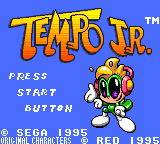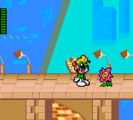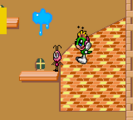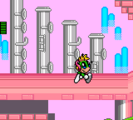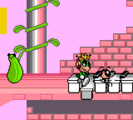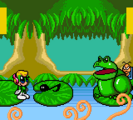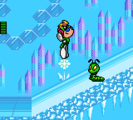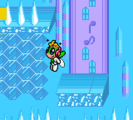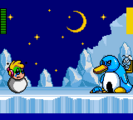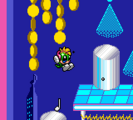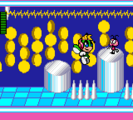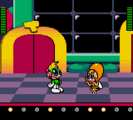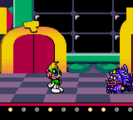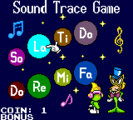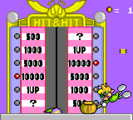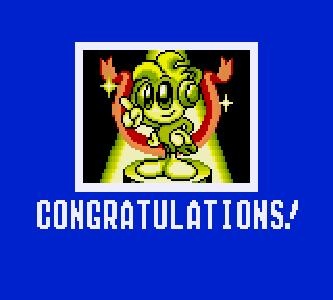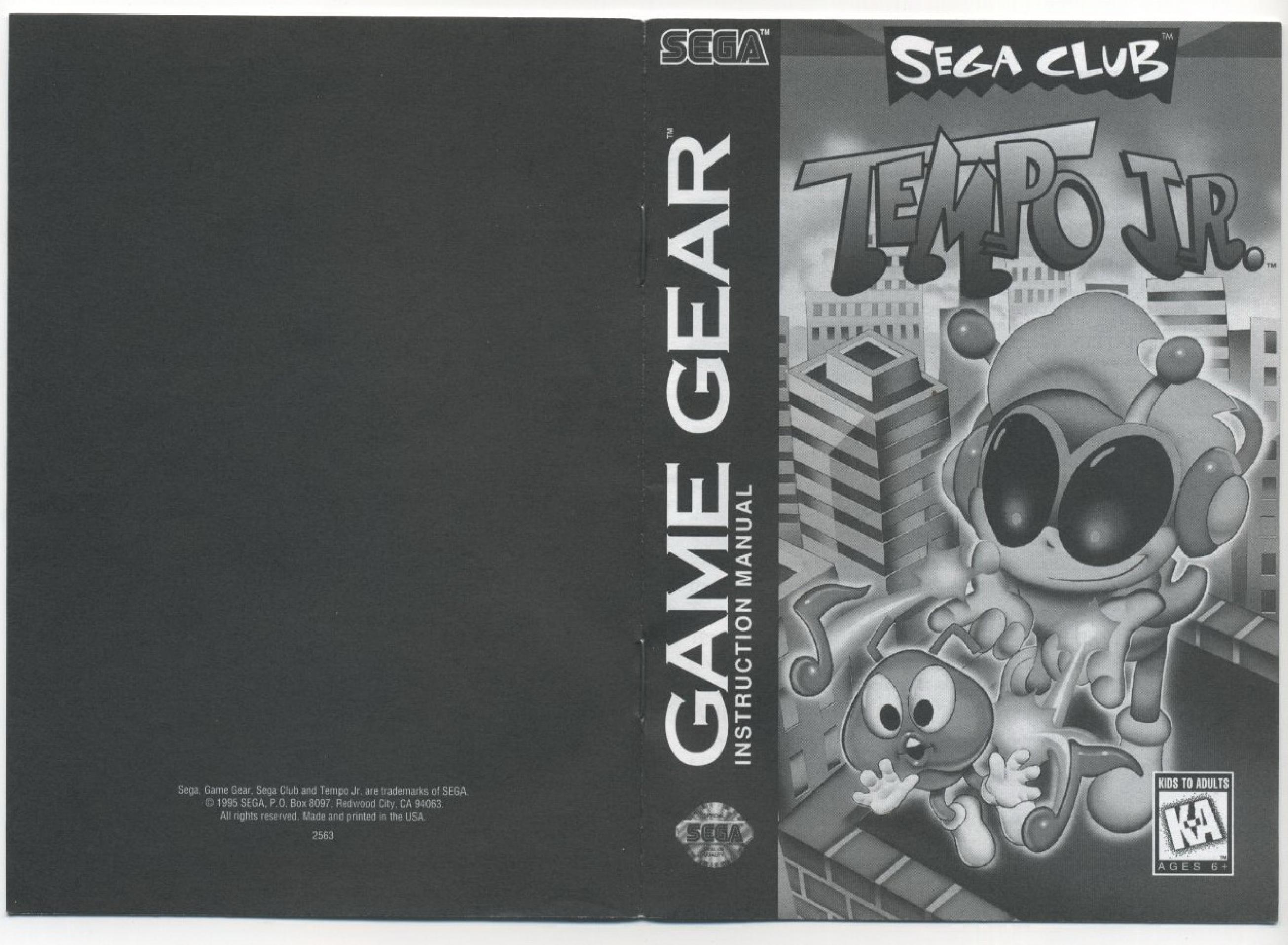Difference between revisions of "Tempo Jr."
From Sega Retro
m (Text replacement - "An Sega Master System GG2SMS hacks was released in" to "A Sega Master System GG2SMS hack was released in") |
MarioSnicU (talk | contribs) |
||
| (20 intermediate revisions by 9 users not shown) | |||
| Line 2: | Line 2: | ||
| bobscreen=TempoJr Title.png | | bobscreen=TempoJr Title.png | ||
| publisher=[[Sega]] | | publisher=[[Sega]] | ||
| − | | developer=[[SIMS]] | + | | developer=[[SIMS]], {{company|[[Sega CS5]]|role=production}} |
| + | | brand={{company|[[Sega Club]]|region=US}} | ||
| system=[[Sega Game Gear]] | | system=[[Sega Game Gear]] | ||
| sounddriver= | | sounddriver= | ||
| Line 19: | Line 20: | ||
| gg_code_eu=2562-50 | | gg_code_eu=2562-50 | ||
| gg_rating_eu=3 | | gg_rating_eu=3 | ||
| + | | gg_date_uk=1995 | ||
| + | | gg_code_uk=2562-50 | ||
| + | | gg_rating_uk=3 | ||
}} | }} | ||
| savetype={{SaveType | | savetype={{SaveType | ||
| Line 24: | Line 28: | ||
}} | }} | ||
}} | }} | ||
| − | + | '''''{{PAGENAME}}''''' (テンポ Jr.) is a 1995 [[Sega Game Gear]] sequel to ''[[Tempo]]''. It is the only game in the series to be released in Europe. It was released under the [[Sega Club]] brand in North America. | |
| − | [ | + | ==Story== |
| + | [[File:Tempo Jr, Major Minor Show.png|thumb|The Major Minor Show]] | ||
| + | The Major Minor Show is a big concert and music festival, hosted by Major Minor. It features a dance contest where Tempo and his friend Katy are set to compete. However, Katy has been kidnapped by the evil Zenza, who is holding her hostage to prevent the pair from competing. Tempo must free Katy in time for the show. | ||
| + | |||
| + | ==Gameplay== | ||
| + | The game is, like its predecessor, a basic platformer about the musically themed adventures of the anthropomorphic grasshopper Tempo. The game is greatly simplified from its forebear because it was targeted towards young children. | ||
| + | |||
| + | Tempo can move around with {{left}} and {{right}} and look up and down with {{up}} and {{down}}. {{Down}} also ducks. He jumps with {{2}} and can hover with his wings by holding {{2}} while in midair. He gradually loses altitude while hovering. Tempo attacks with {{1}}, snapping music notes that stun enemies or kicking them at close range. He also automatically kicks enemies by walking into them if they have already been stunned by music notes. Tempo can run with {{left}}{{left}} or {{right}}{{right}}. While running, he can perform a somersault with {{1}} that defeats any enemies it hits. | ||
| + | |||
| + | Tempo has a strength gauge that starts with four bars. Each time he takes damage by touching an enemy or a stage hazard, he loses a bar of strength. However, he can replenish his strength by collecting Musical Notes, which drop from defeated enemies, or CDs, which are found throughout the stages. Tempo's strength gauge can have as many as 16 bars. When at full strength, the gauge starts flashing, denoting that Tempo can perform his special Dance Attack by pressing {{1}}+{{2}}. This move causes Tempo to do a dance routine that turns all nearby enemies into Gold Coins, which act as credits for use in bonus games (and which can also be found in the stages normally). However, the move costs half of Tempo's strength gauge. | ||
| + | |||
| + | There are no obstacles in the game, such as bottomless pits, that instantly cost the player a life. Instead, Tempo bounces off spikes and water traps so that the player can recover. If Tempo loses all of his strength, he loses a life. If he loses all of his lives, the game ends but the player is given a chance to continue. The player can also reveal a password at this point, which can be used to continue the game at a later time. | ||
| + | |||
| + | ===Items=== | ||
| + | {{InfoTable|imagewidths=50| | ||
| + | {{InfoRow | ||
| + | | title=Musical Note | ||
| + | | sprite={{sprite | Tempo Jr, Items.png | 2 | crop_width=16 | crop_height=16 | crop_x=0 | crop_y=0}} | ||
| + | | desc=Adds a bar to Tempo's strength gauge. Dropped by defeated enemies. | ||
| + | }} | ||
| + | {{InfoRow | ||
| + | | title=CD | ||
| + | | sprite={{sprite | Tempo Jr, Items.png | 2 | crop_width=16 | crop_height=16 | crop_x=16 | crop_y=0}} | ||
| + | | desc=Adds four bars to Tempo's strength gauge. | ||
| + | }} | ||
| + | {{InfoRow | ||
| + | | title=Keynote | ||
| + | | sprite={{sprite | Tempo Jr, Items.png | 2 | crop_width=16 | crop_height=16 | crop_x=32 | crop_y=0}} | ||
| + | | desc=Opens the exit. Tempo must find the keynote on each stage to complete it. | ||
| + | }} | ||
| + | {{InfoRow | ||
| + | | title=Gold Coin | ||
| + | | sprite={{sprite | Tempo Jr, Items.png | 2 | crop_width=16 | crop_height=16 | crop_x=48 | crop_y=0}} | ||
| + | | desc=Gives the player one credit to use for bonus games. | ||
| + | }} | ||
| + | {{InfoRow | ||
| + | | title=Flat | ||
| + | | sprite={{sprite | Tempo Jr, Items.png | 2 | crop_width=16 | crop_height=16 | crop_x=64 | crop_y=0}} | ||
| + | | desc=Makes Tempo's music notes fly downward. | ||
| + | }} | ||
| + | {{InfoRow | ||
| + | | title=Sharp | ||
| + | | sprite={{sprite | Tempo Jr, Items.png | 2 | crop_width=16 | crop_height=16 | crop_x=80 | crop_y=0}} | ||
| + | | desc=Makes Tempo's music notes fly upward. | ||
| + | }} | ||
| + | {{InfoRow | ||
| + | | title=Zigzag | ||
| + | | sprite={{sprite | Tempo Jr, Items.png | 2 | crop_width=16 | crop_height=16 | crop_x=96 | crop_y=0}} | ||
| + | | desc=Makes Tempo's music notes zigzag up and down. | ||
| + | }} | ||
| + | {{InfoRow | ||
| + | | title=Tempo | ||
| + | | sprite={{sprite | Tempo Jr, Items.png | 2 | crop_width=16 | crop_height=16 | crop_x=112 | crop_y=0}} | ||
| + | | desc=Awards the player an extra life. | ||
| + | }} | ||
| + | {{InfoRow | ||
| + | | title=Flower | ||
| + | | sprite={{sprite | Tempo Jr, Flowers.png | 2}} | ||
| + | | desc=Checkpoint where Tempo is revived after losing a life. When Tempo finds it, the flower is wilted and everything around it is dreary. Tempo's sprite becomes glum as he approaches. If Tempo snaps a musical note onto it, it awakens and activates as a checkpoint. | ||
| + | }} | ||
| + | }} | ||
| + | |||
| + | ===Stages=== | ||
| + | The player progresses through four stages (dubbed "performances"). Unlike the first game, the stages progress in a linear fashion instead of being chosen by the player. | ||
| + | |||
| + | Each stage has two parts and a boss fight. To complete each part, Tempo must explore the level for a Keynote, which opens the exit. After completing all four stages, Tempo faces two "Grudge Matches," where two of the previous bosses are randomly chosen to face again, before facing the final boss, Zenza. | ||
| + | |||
| + | {{InfoTable|imagewidths=160| | ||
| + | {{InfoRow | ||
| + | | title=Inner City Performance | ||
| + | | screenshot=Tempo Jr, Stage 1-1.png | ||
| + | | screenshot2=Tempo Jr, Stage 1-2.png | ||
| + | | screenshot3=Tempo Jr, Stage 1 Boss.png | ||
| + | | desc= | ||
| + | }} | ||
| + | {{InfoRow | ||
| + | | title=Through the Woodwinds Performance | ||
| + | | screenshot=Tempo Jr, Stage 2-1.png | ||
| + | | screenshot2=Tempo Jr, Stage 2-2.png | ||
| + | | screenshot3=Tempo Jr, Stage 2 Boss.png | ||
| + | | desc= | ||
| + | }} | ||
| + | {{InfoRow | ||
| + | | title=Winter Wonderland Performance | ||
| + | | screenshot=Tempo Jr, Stage 3-1.png | ||
| + | | screenshot2=Tempo Jr, Stage 3-2.png | ||
| + | | screenshot3=Tempo Jr, Stage 3 Boss.png | ||
| + | | desc= | ||
| + | }} | ||
| + | {{InfoRow | ||
| + | | title=Night Lights Performance | ||
| + | | screenshot=Tempo Jr, Stage 4-1.png | ||
| + | | screenshot2=Tempo Jr, Stage 4-2.png | ||
| + | | screenshot3=Tempo Jr, Stage 4 Boss.png | ||
| + | | desc= | ||
| + | }} | ||
| + | {{InfoRow | ||
| + | | title=Final Showdown Performance | ||
| + | | screenshot=Tempo Jr, Final Boss.png | ||
| + | | desc= | ||
| + | }} | ||
| + | }} | ||
| + | |||
| + | ===Bonus Games=== | ||
| + | Bonus games are played after boss fights if the player has credits from collecting Gold Coins. Each turn costs one credit. They allow the player to play minigames for points and extra lives. They can be skipped by pressing {{Start}} at any point and choosing not to continue. | ||
| + | |||
| + | {{InfoTable|imagewidths=160| | ||
| + | {{InfoRow | ||
| + | | title=Sound Trace | ||
| + | | screenshot=Tempo Jr, Bonus Stage, Sound Trace.png | ||
| + | | desc=A simple memory game where Major Minor plays a series of notes (starting with one but becoming one note longer with each round) and the player is tasked with playing them back correctly. Select a note with the D-pad and {{1}} or {{2}}. | ||
| + | }} | ||
| + | {{InfoRow | ||
| + | | title=Hit & Hit | ||
| + | | screenshot=Tempo Jr, Bonus Stage, Hit & Hit.png | ||
| + | | desc=A timing challenge. Press {{1}} to stop the lights at a goal. The power gauge then cycles, and the player must press {{2}} at the right point to hit the hammer hard enough to reach the goal. If Tempo hits the hammer too hard or not hard enough, he misses the goal and receives nothing. | ||
| + | }} | ||
| + | }} | ||
| + | |||
| + | ==Versions== | ||
| + | ===Localised names=== | ||
| + | {{aka | ||
| + | |en_name=Tempo Jr. | ||
| + | |us_name=Tempo Jr. | ||
| + | |jp_name=テンポ Jr. | ||
| + | |jp_trans=Tempo Jr. | ||
| + | }} | ||
| + | |||
| + | ==Development== | ||
| + | A [[Tempo Jr. (Master System)|Sega Master System version]] game was planned, but eventually cancelled. | ||
==Production credits== | ==Production credits== | ||
| Line 36: | Line 169: | ||
*'''Programmer:''' [[Hirohiko Yoneda]] | *'''Programmer:''' [[Hirohiko Yoneda]] | ||
*'''Chief Designer:''' [[Hiroki Maeda]] | *'''Chief Designer:''' [[Hiroki Maeda]] | ||
| − | *''' | + | *'''Designers:''' [[Hiroko Kato]], [[Masakazu Sato]] |
*'''Sound Programmer:''' [[Keisuke Nishino]] | *'''Sound Programmer:''' [[Keisuke Nishino]] | ||
| − | *'''Special Thanks to...:''' [[Masaru Setsumaru]], Manabu Morinaga, [[Ryoichi Hasegawa]], Yoko Yamamoto, [[Nobuo Matsushima]], [[Bill Person]], [[T's Music|T's Music Co.]], [[Red Entertainment|Red Company]] | + | *'''Special Thanks to...:''' [[Masaru Setsumaru]], [[Manabu Morinaga]], [[Ryoichi Hasegawa]], Yoko Yamamoto, [[Nobuo Matsushima]], [[Bill Person]], [[T's Music|T's Music Co.]], [[Red Entertainment|Red Company]] |
*'''Presented by:''' [[Sega]] | *'''Presented by:''' [[Sega]] | ||
| source=In-game credits | | source=In-game credits | ||
| + | | pdf=Tempo Jr GG credits.pdf | ||
| console=GG | | console=GG | ||
}} | }} | ||
}} | }} | ||
| + | {{hr}} | ||
{{creditstable| | {{creditstable| | ||
*'''Producer:''' [[Mike Larsen]] | *'''Producer:''' [[Mike Larsen]] | ||
| Line 55: | Line 190: | ||
| pdf=Tempo Jr. GG US Manual.pdf | | pdf=Tempo Jr. GG US Manual.pdf | ||
| pdfpage=10 | | pdfpage=10 | ||
| + | }} | ||
| + | {{hr}} | ||
| + | {{creditstable| | ||
| + | *'''Cover artist (US/EU):''' [[Marc Ericksen]] | ||
| + | | console=GG | ||
| + | | source=Uncredited | ||
}} | }} | ||
| Line 66: | Line 207: | ||
}} | }} | ||
}} | }} | ||
| + | |||
| + | ==Artwork== | ||
| + | <gallery> | ||
| + | TempoJr US CoverArt.jpg|US/EU cover art | ||
| + | </gallery> | ||
==Physical scans== | ==Physical scans== | ||
| Line 91: | Line 237: | ||
| front=TempoJr GG EU Box Front.jpg | | front=TempoJr GG EU Box Front.jpg | ||
| back=TempoJr GG EU Box Back.jpg | | back=TempoJr GG EU Box Back.jpg | ||
| − | | | + | | spine=Tempo Jr GG EU BoxSpine.jpg |
| cart=TempoJr GG EU Cart.jpg | | cart=TempoJr GG EU Cart.jpg | ||
| + | | manual=Tempo Jr GG EU Manual.jpg | ||
}} | }} | ||
Latest revision as of 07:36, 3 October 2024
| Tempo Jr. | |||||||||||||||||||||||||
|---|---|---|---|---|---|---|---|---|---|---|---|---|---|---|---|---|---|---|---|---|---|---|---|---|---|
| System(s): Sega Game Gear | |||||||||||||||||||||||||
| Publisher: Sega | |||||||||||||||||||||||||
| Developer: SIMS, Sega CS5 (production) | |||||||||||||||||||||||||
| Brand: Sega Club (US) | |||||||||||||||||||||||||
| Genre: Action[1][2][3] | |||||||||||||||||||||||||
| Number of players: 1 | |||||||||||||||||||||||||
|
Tempo Jr. (テンポ Jr.) is a 1995 Sega Game Gear sequel to Tempo. It is the only game in the series to be released in Europe. It was released under the Sega Club brand in North America.
Contents
Story
The Major Minor Show is a big concert and music festival, hosted by Major Minor. It features a dance contest where Tempo and his friend Katy are set to compete. However, Katy has been kidnapped by the evil Zenza, who is holding her hostage to prevent the pair from competing. Tempo must free Katy in time for the show.
Gameplay
The game is, like its predecessor, a basic platformer about the musically themed adventures of the anthropomorphic grasshopper Tempo. The game is greatly simplified from its forebear because it was targeted towards young children.
Tempo can move around with ![]() and
and ![]() and look up and down with
and look up and down with ![]() and
and ![]() .
. ![]() also ducks. He jumps with
also ducks. He jumps with ![]() and can hover with his wings by holding
and can hover with his wings by holding ![]() while in midair. He gradually loses altitude while hovering. Tempo attacks with
while in midair. He gradually loses altitude while hovering. Tempo attacks with ![]() , snapping music notes that stun enemies or kicking them at close range. He also automatically kicks enemies by walking into them if they have already been stunned by music notes. Tempo can run with
, snapping music notes that stun enemies or kicking them at close range. He also automatically kicks enemies by walking into them if they have already been stunned by music notes. Tempo can run with ![]()
![]() or
or ![]()
![]() . While running, he can perform a somersault with
. While running, he can perform a somersault with ![]() that defeats any enemies it hits.
that defeats any enemies it hits.
Tempo has a strength gauge that starts with four bars. Each time he takes damage by touching an enemy or a stage hazard, he loses a bar of strength. However, he can replenish his strength by collecting Musical Notes, which drop from defeated enemies, or CDs, which are found throughout the stages. Tempo's strength gauge can have as many as 16 bars. When at full strength, the gauge starts flashing, denoting that Tempo can perform his special Dance Attack by pressing ![]() +
+![]() . This move causes Tempo to do a dance routine that turns all nearby enemies into Gold Coins, which act as credits for use in bonus games (and which can also be found in the stages normally). However, the move costs half of Tempo's strength gauge.
. This move causes Tempo to do a dance routine that turns all nearby enemies into Gold Coins, which act as credits for use in bonus games (and which can also be found in the stages normally). However, the move costs half of Tempo's strength gauge.
There are no obstacles in the game, such as bottomless pits, that instantly cost the player a life. Instead, Tempo bounces off spikes and water traps so that the player can recover. If Tempo loses all of his strength, he loses a life. If he loses all of his lives, the game ends but the player is given a chance to continue. The player can also reveal a password at this point, which can be used to continue the game at a later time.
Items
| Musical Note | |
|---|---|
| Adds a bar to Tempo's strength gauge. Dropped by defeated enemies. | |
| CD | |
| Adds four bars to Tempo's strength gauge. | |
| Keynote | |
| Opens the exit. Tempo must find the keynote on each stage to complete it. | |
| Gold Coin | |
| Gives the player one credit to use for bonus games. | |
| Flat | |
| Makes Tempo's music notes fly downward. | |
| Sharp | |
| Makes Tempo's music notes fly upward. | |
| Zigzag | |
| Makes Tempo's music notes zigzag up and down. | |
| Tempo | |
| Awards the player an extra life. | |
| Flower | |
| Checkpoint where Tempo is revived after losing a life. When Tempo finds it, the flower is wilted and everything around it is dreary. Tempo's sprite becomes glum as he approaches. If Tempo snaps a musical note onto it, it awakens and activates as a checkpoint. |
Stages
The player progresses through four stages (dubbed "performances"). Unlike the first game, the stages progress in a linear fashion instead of being chosen by the player.
Each stage has two parts and a boss fight. To complete each part, Tempo must explore the level for a Keynote, which opens the exit. After completing all four stages, Tempo faces two "Grudge Matches," where two of the previous bosses are randomly chosen to face again, before facing the final boss, Zenza.
| Inner City Performance | |
|---|---|
| Through the Woodwinds Performance | |
| Winter Wonderland Performance | |
| Night Lights Performance | |
| Final Showdown Performance | |
Bonus Games
Bonus games are played after boss fights if the player has credits from collecting Gold Coins. Each turn costs one credit. They allow the player to play minigames for points and extra lives. They can be skipped by pressing START at any point and choosing not to continue.
Versions
Localised names
| Language | Localised Name | English Translation |
|---|---|---|
| English | Tempo Jr. | Tempo Jr. |
| English (US) | Tempo Jr. | Tempo Jr. |
| Japanese | テンポ Jr. | Tempo Jr. |
Development
A Sega Master System version game was planned, but eventually cancelled.
Production credits
- Producer: Motoshige Hokoyama, Mike Larsen
- Director: Hideki Katagiri
- Planner: Masakazu Sato
- Programmer: Hirohiko Yoneda
- Chief Designer: Hiroki Maeda
- Designers: Hiroko Kato, Masakazu Sato
- Sound Programmer: Keisuke Nishino
- Special Thanks to...: Masaru Setsumaru, Manabu Morinaga, Ryoichi Hasegawa, Yoko Yamamoto, Nobuo Matsushima, Bill Person, T's Music Co., Red Company
- Presented by: Sega
- Producer: Mike Larsen
- Asst. Producer: Bill Person
- Product Manager: Chrissie Huneke Kremer
- Test Leads: Fernando Valderrama, Al Dutton, Kevin Johnson, Jennifer Vernon
- Testers: Tim Spengler, Peter Clark, Robert Owen, Mark Busalacchi, Chris Charles, Dana Green, Charles Artoux, Jeffery Kessler, Scott Morrison, Howard Gibson, Nathan Clark, Mike Herauf
- Manual: Wendy Dinsmore
- Cover artist (US/EU): Marc Ericksen
Magazine articles
- Main article: Tempo Jr./Magazine articles.
Promotional material
Artwork
Physical scans
| Sega Retro Average | |||||||||||||||||||||||||||||||||||||||||||||||||||||||||||
|---|---|---|---|---|---|---|---|---|---|---|---|---|---|---|---|---|---|---|---|---|---|---|---|---|---|---|---|---|---|---|---|---|---|---|---|---|---|---|---|---|---|---|---|---|---|---|---|---|---|---|---|---|---|---|---|---|---|---|---|
|
| 65 | |
|---|---|
| Based on 11 reviews | |
Technical information
ROM dump status
| System | Hash | Size | Build Date | Source | Comments | |||||||||
|---|---|---|---|---|---|---|---|---|---|---|---|---|---|---|
| ? |
|
512kB | Cartridge | |||||||||||
| ? |
|
512kB | 1994-11-28 | CD-R disc[18] | Page | |||||||||
| ? |
|
512kB | 1994-12-05 | CD-R disc[19] | Page | |||||||||
| ? |
|
512kB | 1994-12-12 | CD-R disc[20] | Page | |||||||||
| ? |
|
512kB | 1994-12-26 | CD-R disc[21] | Page | |||||||||
| ? |
|
512kB | 1995-01-17 | CD-R disc[22] | Page | |||||||||
| ? |
|
512kB | 1995-01-20 | CD-R disc[23] | Page | |||||||||
| ? |
|
512kB | 1995-01-31 | CD-R disc[24] | Page | |||||||||
| ? |
|
512kB | 1995-02-06 | CD-R disc[25] | Page | |||||||||
| ? |
|
512kB | 1995-02-15 | CD-R disc[26] | Page |
References
- ↑ File:TempoJr GG EU Box Back.jpg
- ↑ File:TempoJr GG JP Box Front.jpg
- ↑ 3.0 3.1 https://sega.jp/history/hard/gamegear/software.html (Wayback Machine: 2018-12-07 04:57)
- ↑ Electronic Gaming Monthly, "March 1995" (US; 1995-0x-xx), page 132
- ↑ File:Tempo Jr GG credits.pdf
- ↑ File:Tempo Jr. GG US Manual.pdf, page 10
- ↑ Electronic Games (1992-1995), "July 1995" (US; 1995-0x-xx), page 89
- ↑ Famitsu, "1995-05-05" (JP; 1995-04-21), page 33
- ↑ Game Informer, "June 1995" (US; 1995-0x-xx), page 52
- ↑ Mega Force, "Mai 1995" (FR; 1995-0x-xx), page 72
- ↑ Mega Fun, "07/95" (DE; 1995-06-21), page 74
- ↑ Mega Play, "June/July 1995" (US; 1995-0x-xx), page 49
- ↑ Player One, "Mai 1995" (FR; 1995-0x-xx), page 106
- ↑ Play Time, "(8/9)/95" (DE; 1995-07-05), page 99
- ↑ Todo Sega, "Agosto 1995" (ES; 1995-0x-xx), page 58
- ↑ Top Consoles, "Juin 1995" (FR; 1995-0x-xx), page 107
- ↑ VideoGames, "August 1995" (US; 1995-0x-xx), page 91
| Tempo Jr. | |
|---|---|
|
Main page | Maps | Hidden content | Magazine articles | Reception | |
| Tempo series of games |
|---|
| Tempo (1995) | Tempo Jr. (1995) | Super Tempo (1998) |
- 1 player games
- JP Game Gear games
- All JP games
- US Game Gear games
- All US games
- EU Game Gear games
- All EU games
- UK Game Gear games
- All UK games
- Game Gear games
- 1995 Game Gear games
- All 1995 games
- Game Gear action games
- All action games
- All games
- Credits without reference
- Games with known prototypes
- Old technical information
- Tempo Jr.
- Tempo (franchise)
